7 Best Starter Kids Acoustic Guitars That Your Child Will Love!
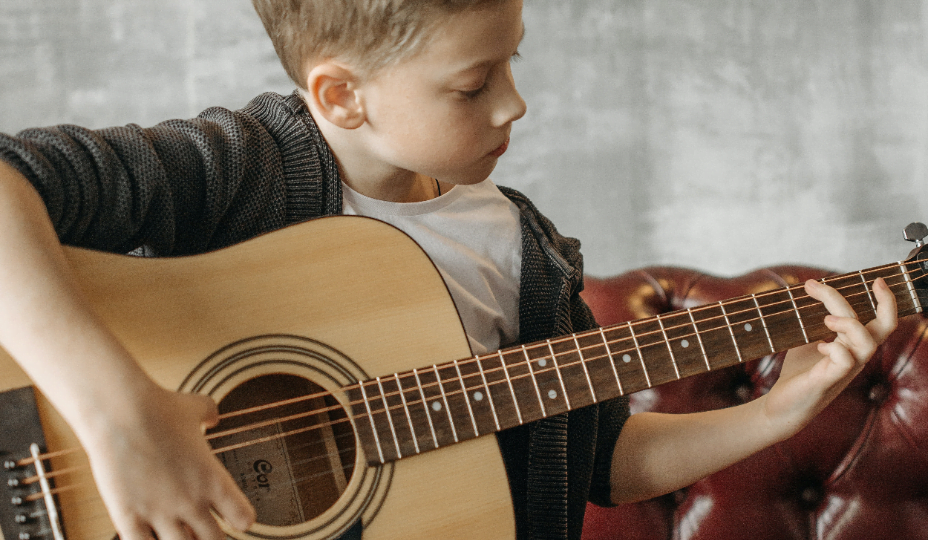
Playing the guitar has many benefits. It helps your child develop memory, self-esteem, attention, creativity and that’s just a tip of the iceberg.
As a good parent, you must do whatever it takes to encourage your kid to love music.
We reviewed and compared the best kids acoustic guitars to help you choose the one that your child will surely love.
Best Acoustic Guitars For Children
Hohner 1/2 Sized Classical model
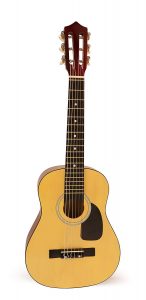
- Sturdy Build Quaility
- Easy Playablity with Nylon Strings
- 1/2 Sized
- 1 Year Warranty
The Hohner 1/2 Sized Classical guitar is 30” in length, has sturdy build quality and is the perfect size for young kids. Featuring nylon strings, that are much easier to play and safe for children. It comes with a songbook and 1 year warranty. The model has accurate intonation and low action which makes it the perfect first instrument for your child.
While this is a great instrument for those children that are taking lessons and are somewhat serious about music, I wouldn’t recommend purchasing a classical guitar for a complete beginner. They have a wider necks than regular acoustic models and are not designed to play common chords. Classical models don’t have frets marked up, which is another disadvantage for new learners. Hohner 1/2 size is quite cheap and is definitely a great instrument for learning or having as a tool for practicing your fingerpicking technique, but if you are serious about purchasing a long-lasting and top-quality classical guitar, I recommend to take a look at some more expensive classical guitar models here.
Pros
- Compact size
- Safe and easy to play
- Great quality
Cons
- Not recommended for beginners
- Need some time to get used to
Taylor GS Mini
- Top: Mahogony
- Body: Mahogony
- Back: Sapele
- Neck: Sapele Wood
- Fretboard: Ebony
When it comes to nurturing a young musician’s passion for the guitar, finding the right instrument can make all the difference. That’s where the Taylor GS Mini comes in, a true gem that I’ve had the pleasure of exploring. Let me take you on a journey through this remarkable acoustic guitar that’s sure to resonate with both budding players and experienced musicians looking for a compact companion.
A Compact Marvel with Big Sound
The Taylor GS Mini is like a magic potion that fuses size with sound. Its scaled-down Grand Symphony body shape doesn’t just make it incredibly comfortable for young players, but it also doesn’t compromise on its ability to deliver a rich and full tone. Despite its smaller stature, the GS Mini boasts a surprising amount of projection and resonance, making it perfect for jamming sessions or intimate performances.
Personal Experience
As I strummed the first chords on the GS Mini, I was blown away by how it effortlessly filled the room with warm and vibrant notes.
A Versatile Companion
Whether your young prodigy is strumming folk tunes or experimenting with fingerstyle techniques, the GS Mini has the versatility to shine in various musical genres. Its responsiveness to different playing styles opens up a world of sonic possibilities, encouraging young players to explore their creativity and find their own unique voice.
A Guitar That Grows with You
The beauty of the Taylor GS Mini lies in its adaptability. As your young guitarist hones their skills and matures as a musician, this guitar will continue to be a steadfast companion. Its exceptional build quality ensures that it will age gracefully and resonate even more beautifully over time, creating a bond that grows stronger with every strum.
In conclusion, the Taylor GS Mini isn’t just a guitar; it’s a vessel of inspiration, a gateway to the world of music, and a reliable partner for a young guitarist’s journey. Its compact size, exceptional craftsmanship, and versatile sound make it a top contender for any aspiring child. If you’re looking to kindle a lifelong love for the guitar in a young kid, the Taylor GS Mini is a choice that hits all the right notes.
Pros
- Remarkable sound in a compact package
- Comfort and portability combined
- A guitar that grows with your child
Cons
- High quality results in high price
Jasmine S34C NEX
- Top: Spruce
- Body: Rosewood
- Back: Nato
- Neck: Mahogany
- Fretboard: Rosewood
Now, let’s turn our attention to the Jasmine S34C NEX, a guitar that exudes elegance and offers an exceptional playing experience. The NEX body shape strikes a perfect balance between comfort and projection, making it a suitable choice for players of all ages. The combination of a spruce top and sapele back and sides results in a well-rounded and articulate tone that will delight young ears.
Harmony in Variety
One of the most exciting aspects of including both the Taylor GS Mini and the Jasmine S34C NEX on our list is the variety they bring to the table. While the GS Mini showcases Taylor’s commitment to quality and craftsmanship, the Jasmine S34C NEX adds a touch of affordability without compromising on sound. This means young players have the freedom to choose the guitar that resonates with their individual style and aspirations.
A Musical Bond that Lasts
Whether your child gravitates toward the intricate details of the GS Mini or the elegant simplicity of the Jasmine S34C NEX, one thing is certain: the bond between the kid and instrument is set to flourish.
Pros
- Affordable Excellence
- Versatile Tone
- Elegant Design
Cons
- Less Premium Materials
Fender Paramount PM-1 Deluxe
- Top: Mahogany
- Body: Mahogany
- Back: Mahogany
- Neck: Mahogany
- Fretboard: Mahogany
One of the coolest things about the PM-1 is how easy it is for kids to play. It’s not heavy or too big, so you can hold it comfortably and play for hours without feeling tired. I remember the first time I held it; it felt like the guitar was just the right size for me, like it was meant to be a part of my musical adventure.
And let me tell you, the more I played the PM-1, the better it sounded. It’s as if the guitar grows with you, getting even more awesome each time you practice. After playing it, I feel like I’ve discovered a hidden treasure that reveals new musical secrets every time I strum those strings.
The PM-1 guitar has a special talent – it creates warm and soulful sounds that are perfect for telling stories through music. Whenever I play my favorite folk tunes, it’s like the guitar is helping me paint a picture with every note, making my songs come alive in a whole new way. And when I add my singing to the mix, the guitar’s rich and clear tones make everything sound incredible.
Now, let’s talk about the part where you press your fingers to make different notes. It’s designed to be super smooth and comfortable, and it’s made from a wood called ovangkol. It might sound fancy, but all you need to know is that it makes the guitar sound amazing, whether I’m playing high notes or low notes. It’s like a secret ingredient that adds a sprinkle of musical magic to every tune.
Oh, and here’s the cherry on top – the part where the strings touch is made from real bone. It might sound surprising, but this bone buddy is what gives the guitar that extra sparkle. When I play softly, the notes linger beautifully, and when I strum with all my heart, the strings come together in perfect harmony, creating a symphony of sound that’s impossible to resist. To sum up
Pros
- Beautiful naturally finished all-mahogany build for creamy warm tones
- Costs reduced by ebony-emulating ovangkol fingerboard
- Open pore finish allows greater resonance and sustain
Cons
- May be shipped with poor intonation; needs setup before playing
Fender FA-115
- Top: Spruce
- Body: Laminated
- Back: Basswood
- Neck: Nato
- Fretboard: Walnut Wood
The Fender FA-115 is the ultimate guitar for kids who are ready to dive into the world of music. From the moment I started playing, it became clear that this instrument is designed with young musicians in mind.
One of the standout features for kids is its user-friendly design. The fretboard is smooth and comfortable, making it easy for small fingers to press down and transition between chords. As a young guitarist, this made learning and practicing a breeze, and I found myself improving faster than I thought possible.
The FA-115’s size is just right for kids, striking a balance between being comfortable to hold and producing a rich, resonant sound. It’s not too heavy, which means I can play for longer without getting tired. The guitar’s body, crafted from spruce and basswood, creates a warm and inviting tone that encourages me to keep playing and exploring new melodies.
While I encountered a few minor challenges, such as the strings taking a bit of time to settle, these were overshadowed by the benefits. The FA-115’s approachable size, comfortable fretboard, and delightful sound make it the perfect companion for young players. Whether I’m strumming my favorite tunes or experimenting with new chords, the Fender FA-115 has truly made my musical journey exciting and fulfilling.
Pros
- Kid-friendly size and design
- Warm and inviting sound
- Durable build
Cons
- You may need to help the child with initial string settling
Rogue Starter Blue Burst – Best value for the money
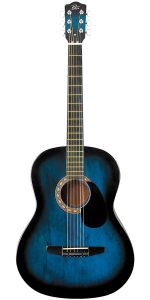
- Smaller body style ideal for kids
- 7/8 scale
- Maple neck
- Rosewood fretboard
- Martin strings
The Rogue starter acoustic guitar is an extremely affordable first guitar for children, featuring a 7/8 scale and petite body design. It comes in six different vibrant colors i.e. Blue burst, Red burst, Pink ,Brown, Black and Matte natural. The model is an amazing deal for a starter, small-bodied guitar. Its smaller profile (7/8″ scale) makes it playable for kids or any aspiring guitarists with smaller body frames and hands. It has a maple neck, rosewood fretboard and Martin strings providing nice tone.
Even though I’ve included this guitar on the list, there are some things that I didn’t like about it. First of all, the action may be too high, which is not exactly good. To be fair, the model does have an adjustable truss rode so you can lower the action, but still it doesn’t change the fact that you may need to do some work. Other than that, Martin strings can be quite hard to play, specially for young fingers.
Bottom line: I do recommend this guitar for your kid if you know how to change guitar strings and use truss rod to adjust action. This is a great choice if you are on low budget. Read our full review of Rogue Starter acoustic guitar.
Pros
- Great look
- Smaller size
- Stays in tune for a long time
- Has a good tone
Cons
- High action
- Hard to play strings
Yamaha JR1
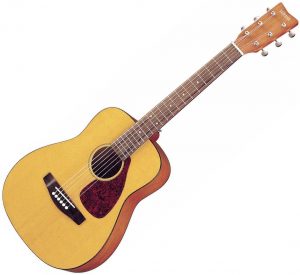
- 3/4 sized guitar
- The JR1 has a smaller body and shorter neck
- 21 frets
- full kit provided
The excellent Yamaha craftsmanship with the use of selected woods for the build of this instrument creates a compact model which gives an authentic acoustic sound. It is the perfect beginner’s guitar in a petite body size. This instrument has amazing sound quality and an outstanding design that is the signature of Yamaha. It comes in a 3/4 size, with a design based on the FG series that makes the mini steel string JR1 one of the top best selling guitars.
As most smaller models, it has a hard time staying in tune for too long. It’s not necessarily a bad thing because even the most expensive guitars do go out of tune and you need to tune them every once in a while. The difference is that might need to do it a little more often. Another particular reason why I often recommend 3/4 size models for children is because it has less fretboard space and it’s easier to switch between chords.
Bottom line: Yamaha JR1 Junior is definitely recommended as a guitar for your kid.
Pros
- Good action
- Great tone
- High quality for a low price
Cons
- Not easy to play on higher frets
- Hard to play with capo on
Martin LX1
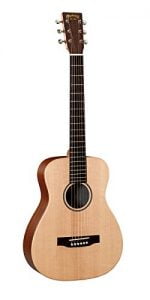
- Mahogany pattern HPL (high pressure laminate) textured finish
- Solid sitka spruce top
- Rust Stratabond neck, shortened 3/4 scale
- Solid Morado or East Indian Rosewood fingerboard
This mahogany pattern high pressure laminate (HPL) comes in a petite size and small scale but holds many features. It is made of Rust Stratabond neck and an East Indian Rosewood fingerboard which helps the Martin sound perfectly tuned and make it travel friendly. It comes with a padded gig-bag and chrome small-knob tuners.
Despite being pricey, this model does deserve to be included to the list. The guitar provides high quality construction and components. You pay more, but you get a long-lasting, high-quality instrument. If your child is interested in playing the guitar, then you should definitely pick Martin LX1. However, if you are not sure if your kid will continue playing the guitar, then you can choose a cheaper model (I suggest Yamaha JR1 Junior).
Keep in mind that the guitar doesn’t have have frets marked up. It’s not a deal breaker, but I think you should at least pay attention to it in case you decide to buy this model. If you’d like to learn more about this model, read our Martin LX1 full review.
Pros
- High quality instrument
- Perfect size for children
- Has bluesy, mellow sound
- Great action
Cons
- No dot marks on frets
- The tone is not that great
- Not cheap
Tips For Buying Your Child A Guitar
While there are many things that should be considered when buying your kid a guitar, there is something really important that is actually helpful for you. Let me tell you a short story that happened to me recently.
A couple of month ago my 10 years old nephew came over my house and saw my full size dreadnought acoustic model. He tried playing it and it seemed like he loved it. So I said: “Hey, you know what, if you like playing this guitar then you can have it. It’s my gift to you”. So he took it home. However, a week later his parents brought it back to me begging me to take it back.
What’s the moral of the story?
Do not buy your kid a loud guitar
Hearing someone practice a guitar is not fun at all. Specially it concerns little children, who may treat playing it more as a fun game than a routine practice.
Even if your child is taking lessons and is somewhat good at it, you still shouldn’t buy a loud guitar. Practicing is all about making mistakes, and hearing that consistently will eventually play on your nerves and cause you headaches.
Don’t get me wrong here, I’m not here to question your kid’s musical abilities. Everything said above comes from my own experience and I’m trying to warn you on what you should expect from buying your child a guitar.
With electric models it’s pretty simple. Unplugged electric guitars sounds very quiet. Plugged electric guitar’s volume is regulated by the amp volume.
Since the sound of an acoustic instruement is produced by air vibrations amplified by the hollow body, the volume of an acoustic guitar is determined by the size of it’s body.
The bigger the body is – the louder it sounds.
With that being said, I recommend avoiding full size models. Your best options are 3/4 or 1/2 size guitars.
The smallest acoustic guitar out there is ukulele, but I do not recommend buying one, because it’s tuned differently from a regular model. A ukulele is not a good option for a beginner player.
Electric or acoustic?
This depends on how serious your kid is about playing the instrument. If he or she is already taking guitar lessons and already has some interest in the instrument, then you can totally buy an electric guitar.
If your kid has never played guitar before and you want to encourage him or her to play it, then I highly recommend getting an acoustic guitar.
Why so?
The answer is simple.
A guitar should be easily accessible. To play an electric guitar, first you need to plug the amp, then plug the guitar, regulate volume etc. This is an additional obstacle that you don’t want your kid to have.
Of course, no. That’s too complicated for the child to do and may be not safe.
On the other hand, an acoustic guitar is always accessible and all you need to do is grab it and play. This easy access to the instrument will allow your child to play it anytime. There is no need to deal with wires, chords, plugs or even a pick to play acoustic guitar.
So, if you are not sure whether you should buy an acoustic or electric model for your child, I recommend an acoustic one.
Know what music your kid likes
Before buying a guitar, something you should really know is your child’s musical style/genre preferences (if he or she already has such). If your kid is a fan of Metallica or metal music in general, then you want to buy a guitar that is appropriate to that style – which is probably a v-shape metal-looking electric guitar.
On the other hand, if your child is more into blues – then you probably want to buy Gibson Les Paul or an acoustic one.
If your child loves Taylor Swift – buy him or her Taylor Swift signature gift! Imagine how excited will your child be about such a gift!
Should You Buy Your Child A Cheap Guitar?
Usually I don’t recommend spending too much money on a guitar because realistically you can get a decent model in a fairly low price range.
However, that’s not the case when it comes to buying an instrument for your child.
These days parents spend so much money on toys that are actually bad for their children. They buy expensive tablets or smartphones just so their children can play games all day long instead of doing their homework or hanging out with friends outside. They spend thousands of dollars on gaming computers and then their children spend all the time home playing video games.
Playing guitar (and music in general) is so much better and healthier of a hobby for a child to have these days.
I do believe that a good parent must do everything he or she can to raise interest to music in their child. Whether it takes to pay a few hundred extra dollars for a good guitar or pay for local lessons – don’t hesitate and absolutely go for it. In a long run you will not regret.
However, if you are looking for a cheap acoustic guitar for your child – whether you are on a tight budget or not sure if your kid will love guitar – then I recommend to check my list of inexpensive acousic guitars here. They won’t break the bank and yet have great quality and sound.
Benefits of playing guitar for children
Playing a guitar has so many benefits that are actually important for growing children.
The benefits of playing guitar for children:
- helps develop their reaction time
- expand short and long-term memory
- develops listening skills
- teaches problem-solving skills
- improves attention
- develops discipline and patience
- enhance your child’s self-confidence and creativity
- serves as a tool to relief stress and express emotions
And what do those $500 smartphones or tablets do for children?
Teach them how to be dumb?
How to become less social?
How to get worse grades at school?
I hope you agree with me that if you encourage your kid to play the guitar and it becomes his or her hobby – then you should consider yourself a happy parent.
I highly recommend not to cheap out on a guitar for your child.
Recommended for reading: The 6 Benefits Of Music Lessons For Kids
What To Look Out For As A Parent When Buying An Acoustic Instrument For Your Kid?
Playing guitar does have some drawbacks that you, as a parent, must be aware of.
The root of the problems is the wrong way that many guitarists use to hold the instrument.
First of all, acoustic models are much lighter than electric ones due to a hollow body. This will significantly reduce the pressure on the back and shoulders of your kid.
Secondly, with a smaller model there is no need to raise the arm too high to hold a guitar, which will reduce the pressure on shoulders and will overall make holding the instrument more comfortable.
Keep in mind that even a smaller acoustic model doesn’t guarantee that your child will hold the guitar correctly without impacting the posture.
It is hard to advise something specific in this case since every child needs a personal approach. I recommend watching this video to get a better understanding of how anyone should hold a guitar (without impacting posture and body in general).
The video is mainly aimed for classic guitar players, but it helps you understand what’s a “healthy” way to hold a guitar.
Recommended for reading: Top 7 Guitar Posture Mistakes.
What Is The Best Age For A Child To Learn The Guitar?
Younger children have the ability to learn things faster. Although it varies from child to child, young children may be quick to follow, but they do have short attention spans which means that they lose what they learn just as quickly as they pick up on it.
This problem can be solved by constant practice and revision of what you want your child to learn. Children as young as 4 years old can start guitar lessons, although the experiences varies form child-to-child and also depends greatly on the teaching method.
Some children start at the age of 5-6 years old. At 7 years old, the child is much more sensible and capable of retaining what he or she is taught. Guitar for 6 year olds and up is a hobby that can develop into a lifelong joy.
It really depends on how motivated and patient the child is with the learning process, and also how devoted the teacher is. Furthermore, it’s important to start with a youth size guitar so your child is not demotivated by the added difficulty of playing an instrument that is too big. For a child to learn how to play the guitar successfully at a young age, you need to invest in a small sized, good quality, long lasting guitar.
What size guitar for a 7 year old depends on your child’s body. A kids sized guitar can range from could be a ½ size acoustic guitar, and ¾ size acoustic guitars might work if your kid is a quick grower, but guitars for teenage beginners will probably be too large.
This investment will make creating some fine-sounding chords really easy and great fun. When they realize that they are capable of playing their own tunes, it’ll motivate them to learn further. Often parents can be too forceful while teaching their child something they wish for them to learn and develop taste for.
Music can be one of the most fun things to learn, and it is actually an extra-curricular activity that promotes creativity and originality in a child. Guitar lessons should not be something that a young child dreads.
This is key to increasing your child’s learning abilities.
Some online applications and websites can be very helpful when it comes to assisting your child in learning.
These can actually make the learning experience much easier if monitored by a parent, because your child can take music lessons within the house, in his or her own comfort zone. Children develop a taste for and become accustomed to what they see around them. If you play the guitar, let your kids sing along and strum with you, it encourages them to learn very naturally.
Recommended for reading: How to Teach Children to Play Guitar
What Size Is The Best For A Kid?
Finding the perfect size guitar for your child is crucial for an easy learning experience. Highly enthusiastic children may wish to for a bigger guitar, because it might make them feel more mature and they may identify with it. Fortunately, there are many options, because what size guitar for 10 year old kids could be a bit bigger than the best ½ size guitars for 4 year olds.
Having to raise your arms above your shoulders to reach over your guitar can be extremely uncomfortable and pull your muscles leading to strain and pain, making it difficult to move your fingers easily across the fingerboard.
Child size guitars make it easy for kids to learn proper technique, including playing style and posture. The best youth guitar is one that encourages learning, fun, and excitement in a child’s new musical hobby.
I recommend buying 3/4 or 1/2 size models. Check out our Best classical guitars for the money buyer’s guide. Generally, classical models are great as the first guitar for a child and they have a warm, mellow sound (which is good for you).
Recommended for reading:
- Best affordable acoustic guitars (under $200)
- Top acoustic guitar choices for starters
- Yamaha FG800 – best value for the money acoustic guitar
- Seagull S6 – top quality acoustic guitar
- Baby Taylor VS Little Martin – comparison





